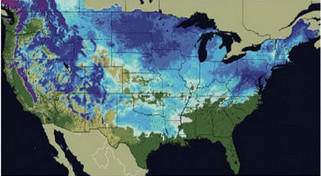
It seems so improbable that no one was sure whether or not it has happened before but there was snow on the ground in 49 of the 50 states on Friday. The unlikely event was possible thanks to snow that hit unusual places like Texas and Florida.
According to the National Weather Service, 67.1 percent of the United States’ total land area was covered by snow yesterday. That far exceeds the 40 to 50 percent normally seen this time of year.
Dallas, Texas recorded an improbable 12.5 inches of snow breaking records for the date and pushing the city to its second snowiest winter on record and its snowiest in 32 years. Not to be left out, snow was on the ground in Arkansas, Alabama, Georgia and even the Florida Panhandle.
Residents in some places in the United States are wishing things weren’t nearly as snowy. The Mid-Atlantic region has experienced record setting snowfalls this year.
Baltimore, Washington D.C., Philadelphia, Wilmington and Atlantic City have all set new records for seasonal snowfall. Many of those cities have experienced more snow than their counterparts in the Rocky Mountain region.
So what was the one state that held out without snow? Hawaii. This is actually unusual as the Mauna Kea volcano peaks at 13,800 feet and often times has snow on it. Research meteorologist Tiziana Cherubini at the Mauna Kea Weather Center told the Associated Press the mountain had been without snow for a few weeks and none is in the forecast.
Officials at Rutgers University’s Global Snow Lab and with the National Weather Service are trying to determine if all 50 states have recorded snow on the ground at the same time. They have verified that 49 states have previously on January 19, 1977 when South Carolina was the lone holdout.
National Weather Service meteorologists attribute the snowy conditions to a moderate El Nino event in the Pacific Ocean and the Arctic Oscillation. In El Nino seasons, moisture streams across the south. The Arctic Oscillation brings colder air from the north dropping temperature and allowing any precipitation that might fall to turn to snow.
 For a complete look at the crazy winter weather across the nation, be sure to visit the Natural Disasters Examiner.
For a complete look at the crazy winter weather across the nation, be sure to visit the Natural Disasters Examiner.
